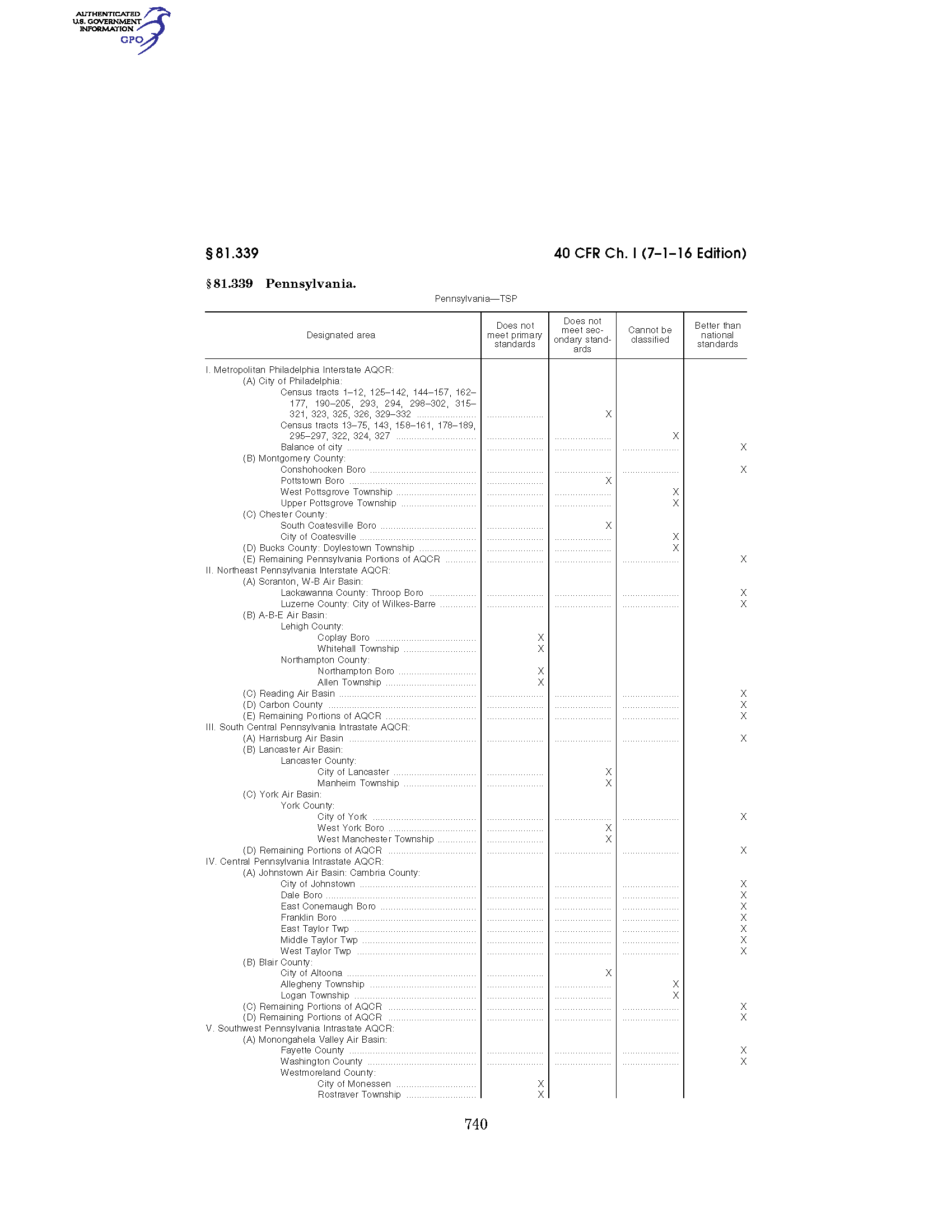Air pollution especially from coke works remains a problem in the region despite some advancements in technology for the industry. The website provides historical documents and videos demonstrating that the air pollution problems encountered today are similar to those encountered in the past.
Simply because the air quality used to be worse in the 1960s does not mean there are no compelling air quality problems in 2016.
Debates about the pollution that the coke plants create have played out in newspaper opinion pages for years in the Pittsburgh area. Framing air pollution as a choice between health and the economy presents a false choice.
Opinion Articles from 1989 (one pro-industry and one pro-environment)
See:
Framing of Two Opinion Pieces in Pittsburgh Press
“For years, the Clairton Coke Works of USX Corp. (U.S. Steel) has been the focal point of a battle over local air quality. The company contends that it is doing a responsible and efficient job in abating pollution and has achieved dramatic results in reducing emissions. Some environmentalists, especially the Group Against Smog and Pollution, dispute those claims, saying that the company has a moral responsibility, extending beyond its legal responsibility, that it is not living up to.”
Two Pieces:
“Inaccuracies Cloud Pollution Risk at Clairton Works”
Summary:
The author, a US Steel executive, notes that the levels of pollution created by Clairton are predicted to be only five percent of the levels in 1970s by the end of the 1980s. This achievement is the result of U.S. Steel’s investment of tens of millions of dollars to update pollution control equipment. These pollution control efforts have led EPA to declare Clairton is one of the “best-operated batteries anywhere in the nation.”
“USX Should Go Beyond Law to Keep County Air Clean”
Summary:
The author states that “there is probably no other industrial facility in the United States which creates a greater danger to the public health than USX’s Clairton Works.” U.S. Steel’s Clairton Works discharges over 6 million pounds of toxic chemicals into Allegheny County’s air every year. The fact that this level of pollution is within the legal limit shows that “mere compliance with the law can be detrimental to the community at large.” The problem with focusing on “mere compliance” is that when air pollution laws become stricter, U.S. Steel will not be prepared to comply and will have to greatly curtail production in order to attain the new emission standards.
Despite $1.2 Billion Upgrade, Clairton Coke Works Still Lagging on Air Pollution, Officials Say
Summary of Article
U.S. Steel invested $1.2 billion to install a new 84-oven battery at Clairton Coke Works, “C Battery,” which began operation in November 2012. This new battery was supposed to “significantly reduce air pollution,” however, U.S. Steel encountered problems trying to operate C Battery within the required emissions limitations. This failure led to continual violation of charging emissions limitations.
The Allegheny County Health Department (ACHD) entered into a consent decree with U.S. Steel to resolve these issues. The August 7, 2014 agreement required U.S. Steel to pay $300,000 in fines. The agreement “gives U.S. Steel until Oct. 31, 2015 to complete installation of a newly designed coke gas collection system on charging portals at the top of the coke ovens, and until April 30, 2016, to certify compliance with the charging emissions limits.”
Despite the violations and needed improvements, ACHD and U.S. Steel claim that the installation of C Battery has reduced air pollution from Clairton by “hundreds of tons.” However, PennFuture criticized the consent agreement for not containing higher fines and for being negotiated without public input.
The experience of the Clairton facility with the C Battery renovation demonstrates that reductions in emissions alone are not enough to ensure good air quality. The concentrations of those emissions are also important. Emissions limitations are developed to ensure a certain level of protection of public health.
PennFuture 60-day Notice of Intent to Sue
http://www.pennfuture.org/UserFiles/File/Legal/CaseUSSteelClairton_GJ_20160128_60DayNotice.pdf
2. Attainment Designations, Attainment Demonstrations, and Attainment Determinations.
To track the status of air quality in Allegheny County, it is important to understand several important terms.
An attainment area designation is performed by EPA to legally identify a nonattainment area. This is important because there are restrictions on the construction of new sources and modification of existing sources in nonattainment areas, to prevent the worsening of air quality in a nonattainment area.
An attainment demonstration is prepared by a state permitting agency to show that an area is expected to reach attainment in the future.
An attainment determination is prepared by EPA to confirm whether an area has reached attainment, as measured by monitoring data.
An attainment area redesignation is performed by EPA to legally change the status of a nonattainment area to an attainment area. For this to happen, a state permitting agency must meet additional requirements in the statute, including the requirement that the emissions reductions be “permanent and enforceable.”
Source: 42 U.S.C. §7513a(a)(1)(B), (b)(2) (requiring a “demonstration” for a particulate matter nonattainment area), §7511a(c)(2)(A) (same, for a serious ozone nonattainment area); §51.908 (requiring an “attainment demonstration” for a nonattainment area under the 8-hour ozone standard), 40 C.F.R. §51.1007 (same, for a fine particulate nonattainment area), §51.1108 (same, for a nonattainment area under the 2008 8-hour ozone standard); 42 U.S.C. §7407(c),(d) (designation and redesignation authority of EPA).
3. Attainment Designations for Allegheny County
Fine particulates (PM-2.5):
All of Allegheny County is designated as nonattainment for the 12.0 micrograms/cubic meter annual standard for PM-2.5 (2013). In ___, the Environmental Protection Agency (EPA) declined the Allegheny County Health Department’s request to restrict this nonattainment designation to the Liberty-Clairton area.
In addition, the following parts of Allegheny County are designated as nonattainment for the 65 micrograms/cubic meter annual standard for PM-2.5 (1997): Lincoln Borough, Clairton City, Glassport Borough, Liberty Borough, Port Vue Borough
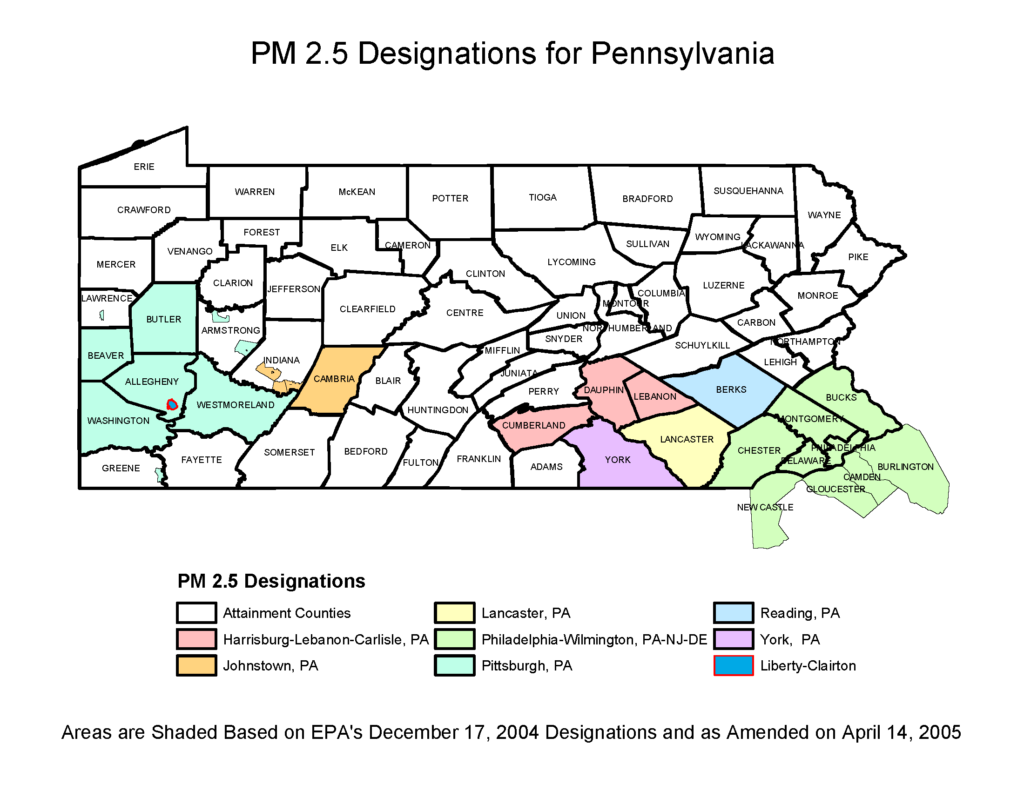
,
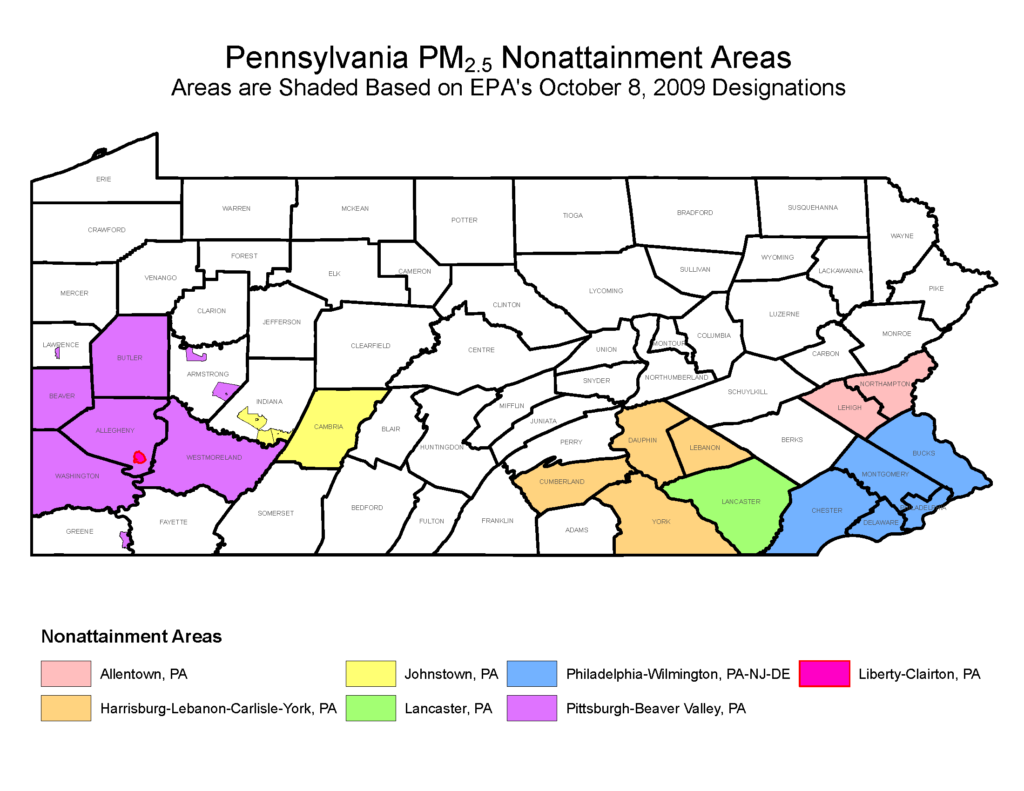
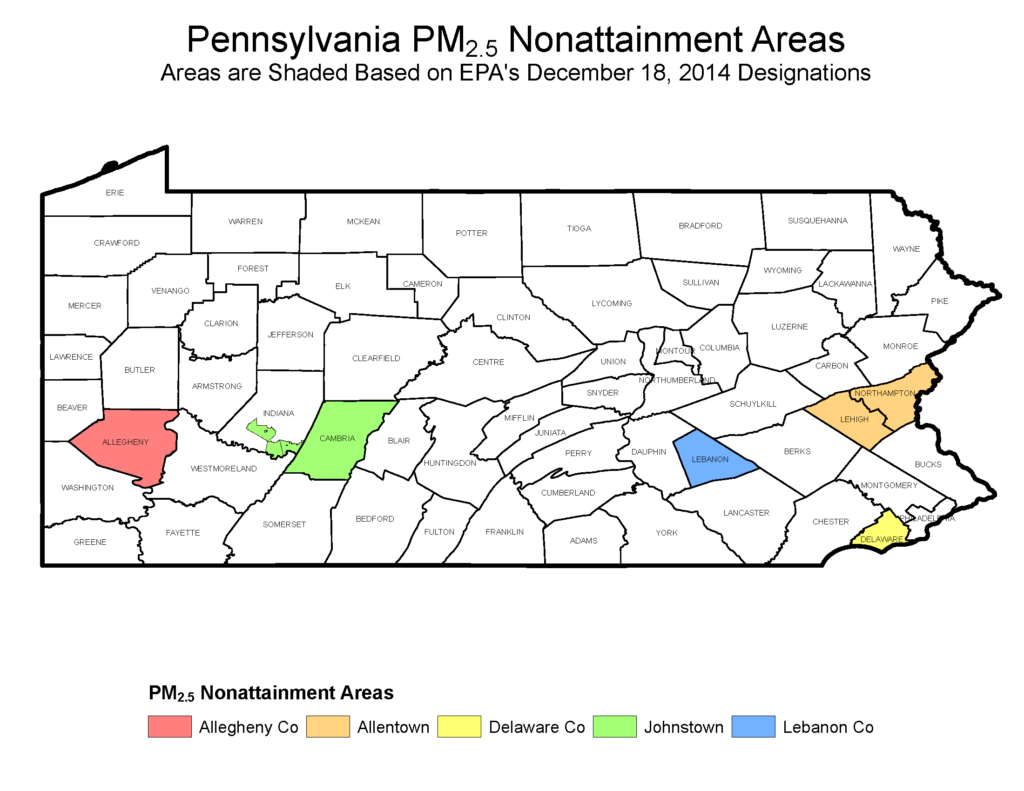
Sulfur Dioxide (SO2):
As of October 4, 2013, the following parts of Allegheny County are designated as nonattainment for the 75 ppb standard for sulfur dioxide:
Boroughs of Braddock, Dravosburg, East McKeesport, East Pittsburgh, Elizabeth, Glassport, Jefferson Hills, Liberty, Lincoln, North Braddock, Pleasant Hills, Port Vue, Versailles, Wall, West Elizabeth, West Mifflin;
Cities of Clairton, Duquesne, McKeesport; and
Townships of Elizabeth, Forward, North Versailles.
Ozone (O3):
As of June 13, 2012, all of Allegheny County is designated as nonattainment for the 0.08 ppm 8-hour standard for ozone (primary and secondary) (1997).
As of June 13, 2016, all of Allegheny County is designated as nonattainment for the 0.075 ppm 8-hour standard for ozone (primary and secondary) (2008).
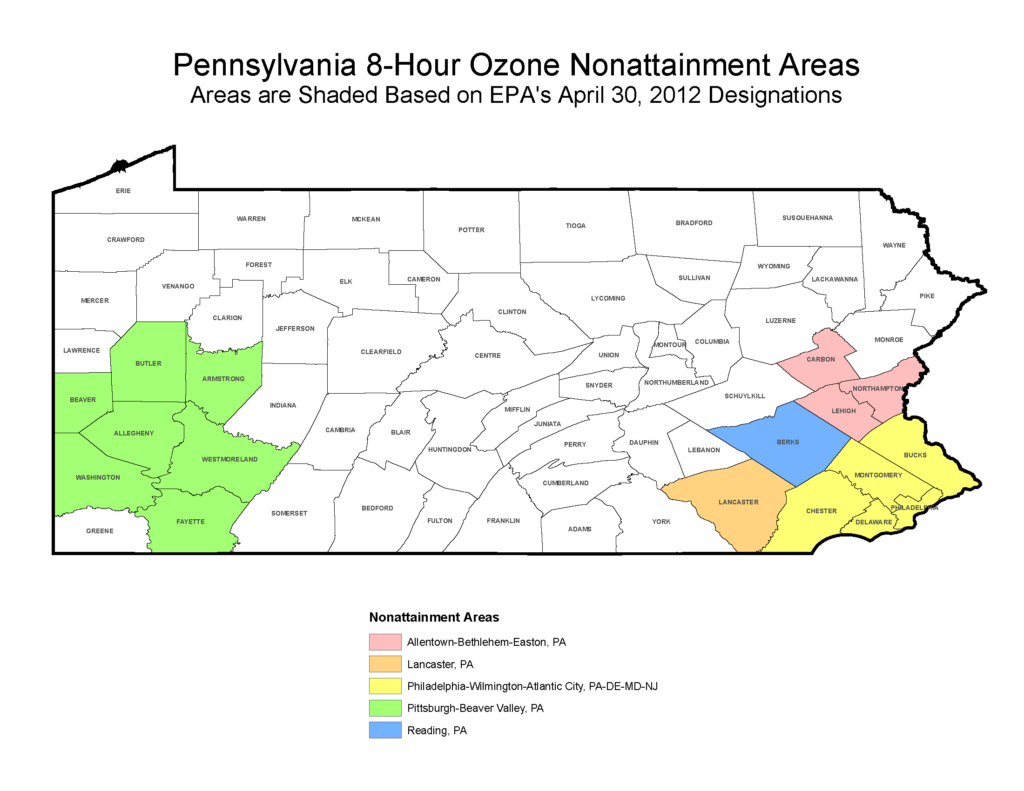
3. Attainment Determinations for Allegheny County
For more information relating to the history of Allegheny’s attainment and nonattainment with these standards, click here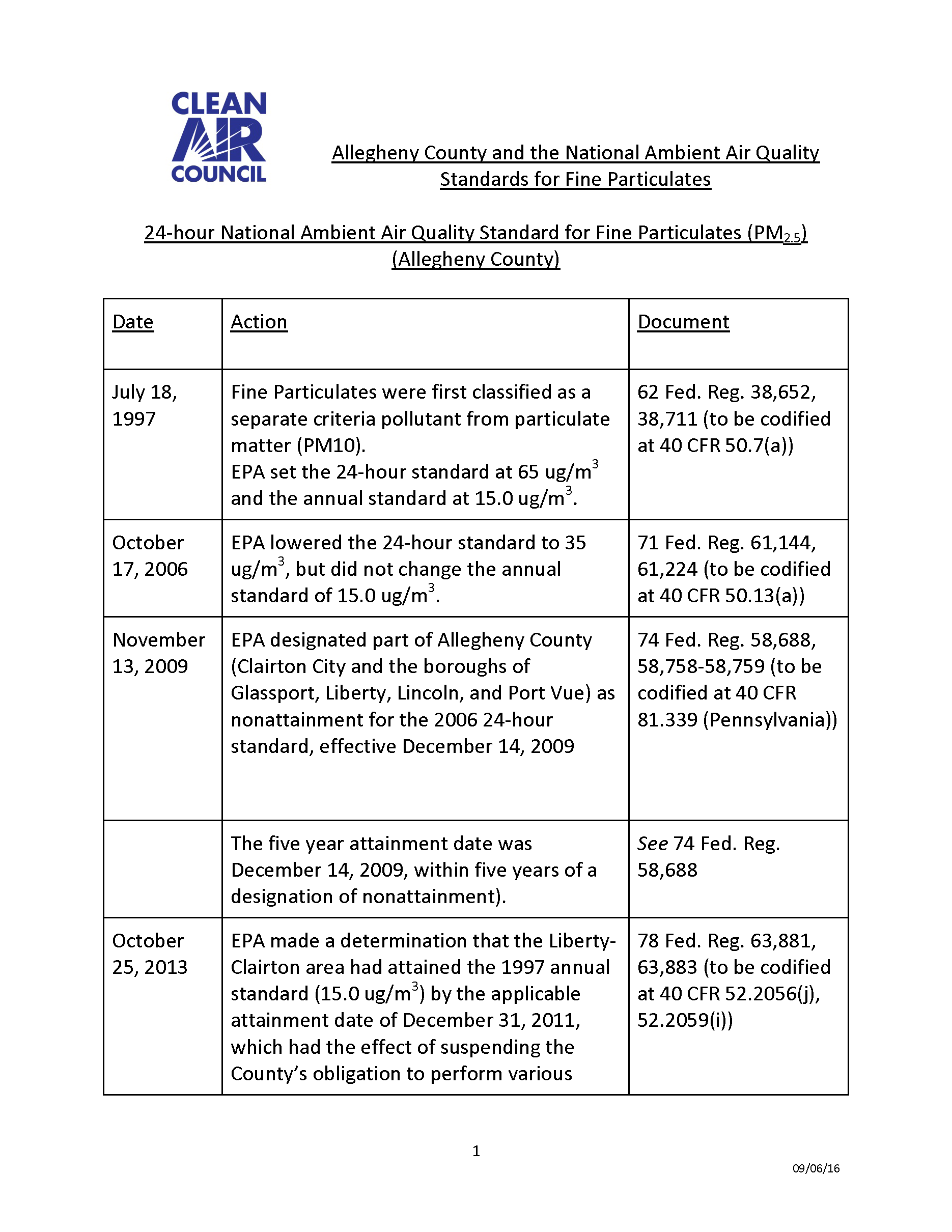
Attainment and Nonattainment for All Pollutants:
https://www3.epa.gov/airquality/greenbook/anayo_pa.html
PM-2.5 (24-hour Standard in 2006): https://www3.epa.gov/airquality/greenbook/rncty.html
PM-2.5 (Annual Standard in 1997): https://www3.epa.gov/airquality/greenbook/qncty.html
PM-2.5 (Annual Standard in 2013), https://www3.epa.gov/airquality/greenbook/kncty.html
8-hour Ozone Standard (2008): https://www3.epa.gov/airquality/greenbook/hncty.html
8-hour Ozone Standard (1997), https://www3.epa.gov/airquality/greenbook/gncty.html
Pennsylvania Attainment and Nonattainment Status for All Pollutants: https://www3.epa.gov/airquality/greenbook/anayo_pa.html
